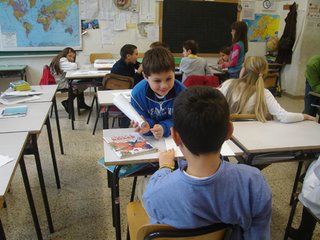
Today I had one of the best experiences of my Italian adventure. We didn’t take a train anywhere. In fact, our destination was about a twenty minute walk from our school. There were no famous pieces of art or history where we ended up. It was an Italian elementary school, where we had an hour to observe and talk to the students.
I love working with kids. I did a bit of student teaching fall semester last year in a kindergarten classroom, volunteered in a third grade room all last year, and spent last May in Chicago in a high school. (Not to mention working with children all summer long at camp!) Needless to say, I was really missing that part of my life over here. 
However, this morning we had the opportunity to go in to talk to third graders about schools in America and ask them questions about their own. Talk about overwhelming! Kids at that age are stressful enough. Add in the fact that they’re talking a mile a minute in a language you’re far from fluent in and that discipline is FAR more lax in Italy…all six of us were immediately wondering what our professor had gotten us into as soon as we arrived. But as we stood there in the doorway, debating what in the world to do, all of the kids turned around and greeted us, with huge smiles, “GOOD MORNING!” It was adorable.
We situated ourselves in front of the class, and the teacher, who spoke a fair amount of English, explained that they wanted to introduce themselves. So they went around the room, saying their names, then, with a slightly hesitant (but excited) glance at each other, all chimed out at the same time, “What’s YOUR name?” It was obvious they had been taught a few key phrases before we arrived and were eager to try them out with REAL Americans.
The six of us introduced ourselves and then performed a short skit demonstrating a typical day in an American elementary school. Our plan was then to ask if the students had any questions, have the “maestra” translate, and then ask the question back to get an idea about the Italian school day. However, as soon as we had finished, about five hands shot up and waved eagerly in our faces, another handful of kids simply started shouting out questions, and yet another bunch jumped out of their seats to go talk to a friend across the room or come right up to us with their question. We quickly looked at the teacher, who looked completely nonplussed by the behavior, and nodded at us to go walk around the room to talk to individuals. I’m sure it was the most amusing thing in the world for these nine year olds to hear students in their 20s stumbling over asking basic questions in Italian like, “How do you get to school?” They were absolutely adorable though, and completely in awe of us and everything we said or did.
After our skit, the students were so excited; they wanted to put on their OWN skit for us about their own school day. So they did just that.

The kids were incredibly animated. The stereotype that Italians are overly enthusiastic when it comes to gesturing and using their hands while talking is completely true–even in children. When the teacher explained we would be doing a skit, one little boy, Filippo, clapped his hands together and shouted, “Oh, BELLO!” When we finished, he kissed his fingers dramatically and cried out, “Elision, bellissimo!”
Our hour flew by, much to our disappointment. We all wanted to stay for much longer. The teacher told us that the class is putting on a school play in December and we’re invited. We can’t wait. As we waved ciao to the class, they all eagerly called out “goodbye!” to us. Is there really any better way to start a day? I didn’t think so.
 Starting December 20th, Perugia’s Sant’Egidio Airport will clear it’s runways for a welcome addition, Ryan Air. Perugia will soon have direct connections to one of Europe’s most popular travel destinations, London, England.
Starting December 20th, Perugia’s Sant’Egidio Airport will clear it’s runways for a welcome addition, Ryan Air. Perugia will soon have direct connections to one of Europe’s most popular travel destinations, London, England.














